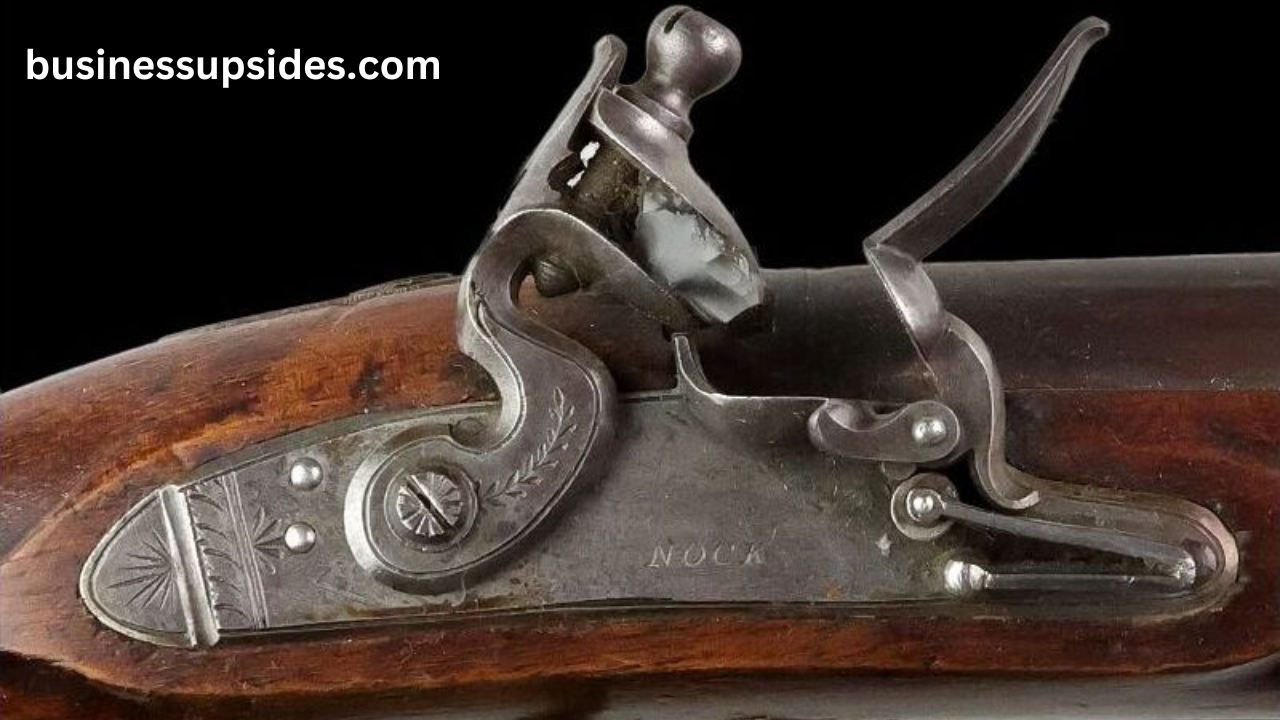The Nock Screwless Lock Revolutionizing Firearm Design
The evolution of firearm technology is marked by various innovations that have fundamentally shaped the weapons we know today. Among the many key figures who contributed to these advancements, Henry Nock, a British inventor and gunmaker, stands out. His invention of the screwless lock is one of the most significant innovations in firearm history, making a lasting impact on gun designs, particularly in the late 18th century. In this article, we will explore the origins of the Nock screwless lock, its functionality, and its influence on the firearms of the era.
The Life of Nock screwless lock: A Visionary Gunmaker
Henry Nock was born in 1741 in London, England, and became one of the most renowned gunmakers of his time. Nock’s early career saw him working with firearms, initially as an apprentice, before establishing his own gunmaking business in the 1770s. He specialized in designing and manufacturing military firearms, and over time, he became a trusted supplier to the British Army.
Nock was highly regarded for his ingenuity, with many of his designs pushing the boundaries of contemporary firearm engineering. However, his most celebrated innovation would come in the form of a nock screwless lock, a mechanism that would significantly improve the overall design and functionality of firearms.
The Need for Innovation in Firearm Locks
Before the advent of Nock’s screwless lock, most firearms used traditional lock mechanisms that were assembled with screws. While this design was functional, it presented several drawbacks. Screws could become loose during extended use, which would impair the reliability of the firearm. Additionally, the presence of visible screws made the weapon’s exterior less aesthetically pleasing and more difficult to maintain.
As firearms became more sophisticated, particularly with the development of flintlock mechanisms, there was a clear need for a more durable, efficient, and visually appealing solution. Gunmakers and inventors sought to address these issues, and Henry Nock’s screwless lock provided just the answer.
The Nock Screwless Lock: A Game-Changer
Nock’s screwless lock design eliminated the need for screws in the assembly of firearm locks, marking a revolutionary departure from previous practices. Instead of screws, the components of the lock were secured using precisely machined parts that fit together without the need for external fasteners. This not only enhanced the structural integrity of the firearm but also contributed to a more streamlined and visually attractive design.
One of the primary benefits of the screwless lock was its improved durability. Without screws, which could loosen over time, the lock’s components remained securely in place, even under the stresses of repeated firing. This made the firearm more reliable and reduced the chances of malfunctions.
Moreover, the screwless design also improved the ease of disassembly and reassembly of the firearm. Gunmakers and users no longer had to worry about stripped screws or misalignment when reassembling the lock. The precision-engineered components fit together in such a way that they could be easily reassembled without tools, making maintenance and cleaning significantly easier.
Another important feature of the Nock screwless lock was its aesthetic appeal. With no visible screws or external fasteners, the lock presented a smooth, clean appearance. This was particularly important for military firearms, where both functionality and presentation were crucial. The elegance of the screwless lock was seen as a testament to the advanced craftsmanship of Henry Nock and his company.
The British Pattern 1796 Heavy Dragoon Carbine: A Notable Application
Perhaps the most famous firearm to feature Nock’s screwless lock was the British Pattern 1796 Heavy Dragoon Carbine. This was a carbine designed for use by the British Army’s cavalry, specifically the heavy dragoons, who required a reliable and durable firearm for combat.
The Pattern 1796 Carbine was a significant departure from earlier cavalry carbines, incorporating several design improvements. One of the most important innovations was the use of Nock’s screwless lock, which helped to ensure the firearm’s durability and ease of maintenance in the field. The absence of screws meant that the lock was less prone to damage and was easier to maintain during military campaigns.
The carbine was also designed to be lightweight and compact, making it easier for cavalry soldiers to wield in combat. Its shorter length allowed for quick handling, and its smoothbore barrel was capable of firing a variety of ammunition types, including buckshot and round balls. These features made the British Pattern 1796 Heavy Dragoon Carbine a versatile and effective weapon.
Previous article; The Silent Crisis: Unraveling the Effects of Substance Abuse
The screwless lock in this carbine was a clear reflection of Nock’s commitment to innovation, providing a reliable and aesthetically pleasing solution for military firearms. The Pattern 1796 Carbine became widely adopted by British forces and was used in numerous campaigns during the late 18th and early 19th centuries.
Technological Advantages of the nock screwless lock
The screwless lock designed by Henry Nock offered several distinct technological advantages over traditional screw-based locks:
- Enhanced Durability: Traditional locks with screws were prone to loosening over time, especially under the stress of repeated firing. The screwless lock, by contrast, held its components in place more securely, ensuring the firearm remained reliable during extended use.
- Easier Maintenance: One of the major selling points of the screwless lock was its ease of disassembly. Without the need for screws, the components could be easily taken apart and reassembled, which simplified cleaning and maintenance. Gunmakers and soldiers alike found that the screwless design saved time and effort in keeping firearms in working order.
- Aesthetic Appeal: The smooth, screwless design gave firearms a cleaner, more polished appearance. In an era where appearance was often as important as function, this made Nock’s designs more appealing to military and civilian buyers.
- Reduced Malfunctions: With no screws to loosen or become damaged, the nock screw less lock reduced the likelihood of malfunctions in the field. This was especially important in military combat, where a malfunctioning firearm could be a matter of life and death.
- Precision Engineering: The success of the screwless lock was due to the precision with which Nock and his workshop crafted the parts. The components had to fit together with such accuracy that they could hold the lock mechanism in place without the need for screws. This demonstrated the advanced engineering capabilities of Nock’s workshop.
The Legacy of the Nock Screwless Lock
The impact of Nock’s screwless lock was far-reaching. While it did not immediately replace all other lock designs, it demonstrated the potential of precision engineering in firearm construction and inspired other gunmakers to explore similar innovations.
The success of the screwless lock helped solidify Henry Nock’s reputation as one of the leading firearms engineers of the 18th century. His work would influence not only the design of future firearms but also the broader field of military technology.
Although Nock’s screwless lock was eventually supplanted by other technologies, particularly the development of percussion locks in the early 19th century, its influence can still be seen in modern firearms. Today, many firearms continue to rely on precision engineering and smooth, screwless mechanisms to ensure reliability and ease of maintenance.
Challenges and Limitations of the Screwless Lock
While the screwless lock was a significant advancement in firearm design, it was not without its challenges and limitations. One of the primary concerns was the complexity of manufacturing such a precise mechanism. The precision required to fit the components together without the use of screws meant that each lock had to be carefully crafted, which increased production costs.
Additionally, while the screwless design was more reliable than traditional screw-based locks, it was not entirely immune to failure. Over time, some components of the screwless lock could wear down or become damaged, which would require replacement or repair. In the harsh conditions of battle, these issues could still pose challenges for soldiers relying on the firearm.
Despite these limitations, the screwless lock represented a major leap forward in firearm design and set the stage for future innovations.
Conclusion
The Nock screwless lock stands as one of the most important innovations in the history of firearm design. Henry Nock’s ingenious solution to the problem of loose screws and unreliable firearm locks revolutionized gunmaking, leading to more durable, reliable, and aesthetically pleasing firearms. The British Pattern 1796 Heavy Dragoon Carbine, with its screwless lock, is just one example of the impact that Nock’s invention had on military firearms during the late 18th century.
Though the screwless lock eventually gave way to new technologies, its legacy continues to influence modern firearms. Nock’s commitment to precision engineering and his visionary approach to firearm design have left a lasting mark on the industry, and his screwless lock remains an enduring symbol of innovation in the history of firearms.










Post Comment